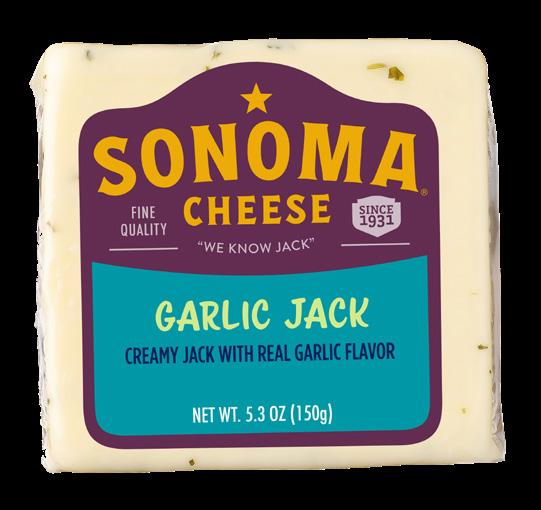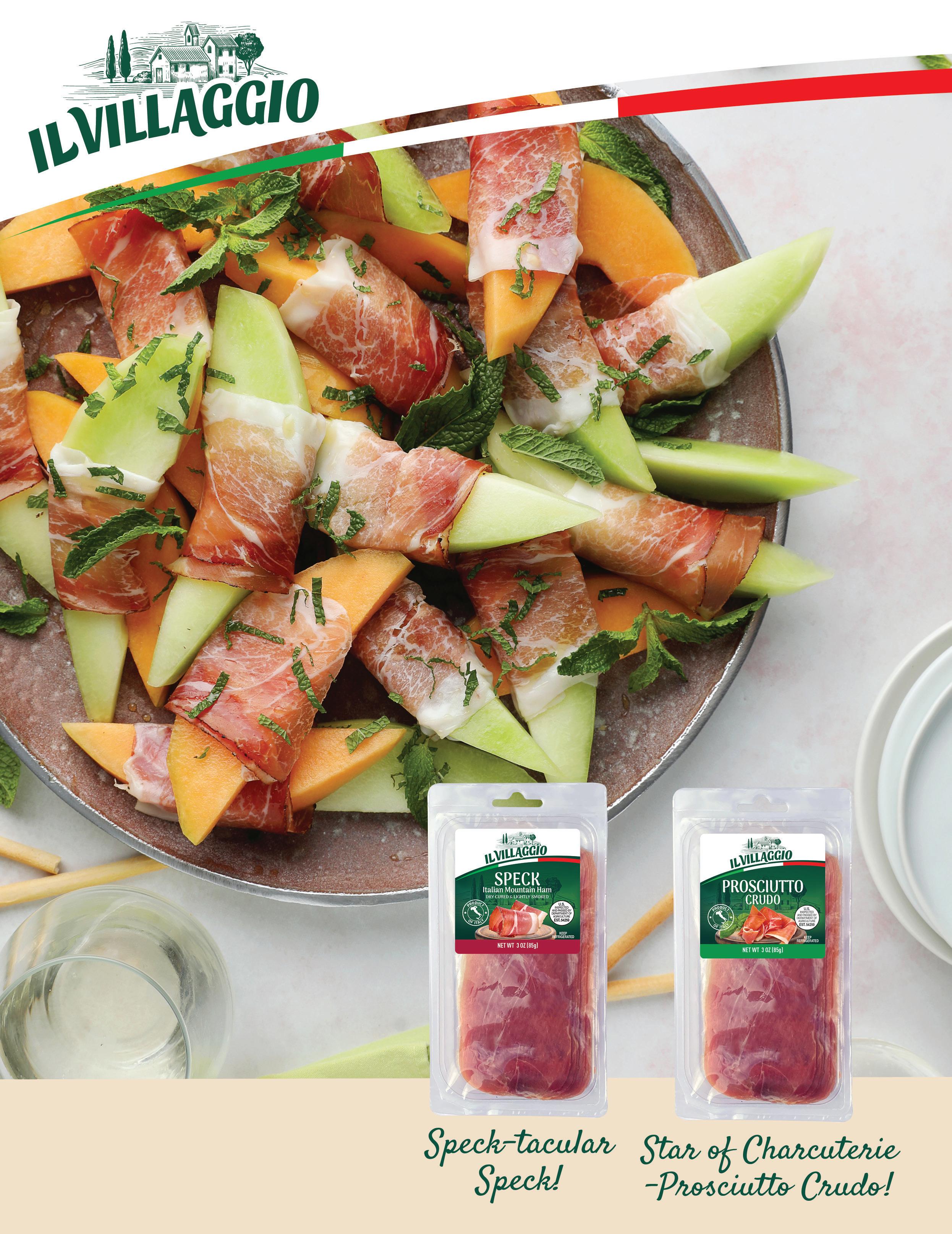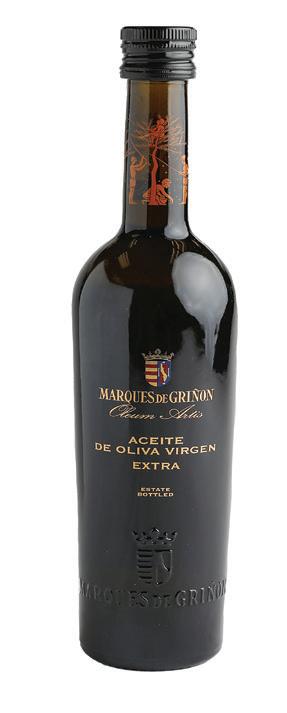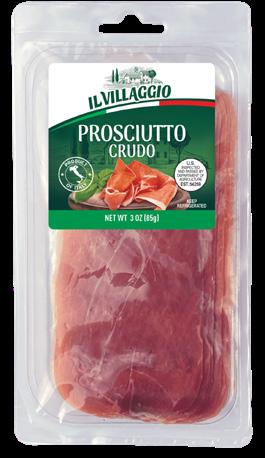


ON THE COVER

Little Treats Hit the Big Time
Small and upscale is all the rage. 10 Saying Cheese
Making the case for cheese with today’s consumer.
16
Design of the Times
Atalanta’s own design team talks packaging.
24
Navigating Crisis
Avoiding delays due to logistical dilemmas. 26
Olive By Any Other Name
Getting specific about oils. 31
New Item Roundup
Our newest tasty offerings.


A note from Tom Gellert, President of Corporation
Welcome to First Bite! It’s only June, and it’s been an incredible year already.
We’re proud of launching new items and new brands to help our customers succeed. Cracking Good, high-quality cheese from the British Isles with a sense of humor, is the latest addition to our portfolio of owned brands, joining the most recent acquisitions of Mt Vikos and Sonoma Cheese.
The market is showing substantial growth. IL Villaggio and Casa Flores are expanding their portfolios to feature more convenient, top-quality offerings.
DeMedici celebrated 45 years of sourcing specialty foods crafted by artisans who produce the finest quality the world has to offer. DeMedici is excited to announce a new partnership with New Zealand-based Olivado. DeMedici’s expertise in importing and its large distribution network makes it a great fit to import and distribute the brand’s premium avocado, macadamia, and coconut oils.
As always, we’re committed to keeping our customers ahead of the curve and aware of the latest news and its impacts. In this issue, we’ll also discuss Baltimore’s Francis Scott Key Bridge collapse. Although the tragic event had minimal effect on us, we’re diversified to mitigate future emergency supply chain risk. Over our 79-year history, we’ve become adept at navigating supply chain disruptions - and even more so in the last 4 years, during which time we’ve acquired even more expertise to protect our business and our customers.
We hope you enjoy this issue of First Bite. It’s packed with information and ideas. Read on to learn about packaging trends and innovative rebrands, Gen Z and Gen Alpha’s “Little Treat” mentality, plus info on the latest trend in menu descriptions.




“I deserve a little treat.”
It’s a phrase popularized in the past two years that has made headlines for how it has impacted consumer buying gaining 49.5 million posts on


financial stressors caused by recent waves of inflation, these little treats put discretionary income back in consumers’ control and help to alleviate stress. They deliver small moments of joy.
Technomic dubbed a similar phenomenon ‘YOLO (You Only Live Once) spending’ and it ties to a new spending habit of over-reaching your budget, but tends to apply more to higher ticket items—such as renting a yacht for the day or a short luxury vacation.

consumers are pushing back on the mentality that skipping their weekly indulgences would suddenly add up to a down payment for a house. They’ve done the math; forgoing a weekly “little treat” like a Starbucks latte doesn’t mean much savings back in their pocket in the long run. With

We sat down with Technomic’s Donna Crecca, to learn a bit more.
FIRST BITE: What are the key differentiators between “little treat” and “YOLO spending”?
DONNA CRECCA: “In my mind, little treat relates to affordable indulgences that brighten the consumer’s day – like a specialty coffee in the afternoon or a nice cocktail at the bar. YOLO spending leans towards the more extravagant.”
FB: What are some of the main factors you see playing into this trend? (i.e. macroeconomic instability, post-pandemic, personal finances are tighter, etc.)
DC: “Consumers today continue to feel pressure on their personal finances and recognize the macroeconomic
unevenness and the geopolitical uneasiness. They’re looking for respites from the persistent pressures and stressors.”
FB: What generation are you seeing participate in this trend the most? Why do you think that is?
DC: “I’d say all generations are seeking little treats in the current environment, but seniors are often seen as the primary drivers of the YOLO trend.”
So, how does the little luxury trend impact the food industry? We’ve seen the shift of menus to incorporate more ‘Instagrammable’ traffic-driving LTOs in recent years. Operators are now taking it a step further. Creating a ‘craveable’ section call out on menus is now the #10 trend on the Top 50 Menu Trends to Watch.† A permanent section of the menu dedicated to craveable indulgences could help compete with quick service and grab & go concepts at retail- the easiest ways to indulge in an afternoon snack. The second impact we’ve seen from this phenomenon is that boba tea and beverage concepts are booming.

Many beverage spots are featured on Technomic’s list of Restaurant Concepts on the Horizon, with Beverage/Snack concepts growing 231% in the past 15 years amongst the top 1500 chains and putting pressure on traditional coffee cafes.‡ Mintel reports non-alcoholic beverages are viewed as indulgent and uplifting-an affordable indulgence. But Mintel also discovered that price fluctuations can threaten beverages “beloved treat” status, tying back to the core driver of the ‘little treat’ trend.§
What do you think? Have you noticed your customers seeking more “little treats”?
Let us know @AtalantaCorp on Instagram
SOURCES:
* TikTok.com
† https://www.huffpost.com/entry/little-treat-culture-gone-too-far-therapists_l_65b00b52e4b0d65b024e451d ‡Technomic, Inc. 2024
§Mintel NON-ALCOHOLIC BEVERAGES IN FOODSERVICE – US – 2024



READY TO BAKE
Perfect for sharing as a rich and creamy dip, Snowdonia Cheese Co.’s new hot cheese bakes are crafted using the finest natural ingredients and ready to serve in 22 minutes.


Every few months, it seems there’s a new diet trend in the news, fed by influencers and celebrities. At their core, these diet trends reflect an ever-stronger focus on health and longevity. No food category is exempt from this focus. This presents a both a challenge and an opportunity for retailers, suppliers, and makers. Stocking your cheese case with multiple enticing and healthy options, and training your staff on their benefits, is your best chance to turn challenges into benefits.
Cheese is an Excellent Source of Protein
One of the themes that overarches all diet trends is the drive to ‘eat healthy’. Today’s focus on balanced carbohydrate and protein, healthy fats, low processing, all coupled with gut health puts the cheese department in a great place to talk about options. Cheese is a great source of healthy protein and natural source of B12, an important nutrient.
Cheese Takes Center Stage
When planning your fully stocked cheese offerings, having variety is key, but it’s also important to include cheeses that are designed to be the central ingredient in a meal. Paneer is a very mild cheese prominent in Indian, Pakistani, Nepalese, and other diets. Made without rennet, Paneer holds its shape when heated. It can be seasoned and grilled, cut into cubes marinated and baked, or even rolled in
a coating and fried. Paneer also shows up in fusion cuisine like cubed on a tandoori flatbread or thinly sliced for tacos.
Another cheese that can be central to a meal is Halloumi. Hailing from Cypress, Halloumi is a pressed and cooked curd cheese that when grilled crisps on the outside but gets gooey on the inside. It is a traditionally made with goat and/or sheep milk, and has a lactic, salty flavor. Demoing Atalanta Halloumi by slicing and sauteing it in a little olive oil will bring crowds to the counter!


The #1 selling Paneer in the US ! Inspired by the traditions of the Indian Subcontinent, Royal Mahout brings premium, authentic, and approachable flavors to every meal. With Royal Mahout products, your tastebuds will be transported to tables around the world!
Necessity or Choice



There are few things more difficult for cheese mongers to manage than customers who may have medical conditions like lactose intolerance and are convinced that they can never eat any cheese. But surprisingly, the cheesemaking process is what renders many cheeses low in lactose.
But no retailer wants to either correct a customer about lactose or send them home with a product that will cause pain. So, knowing the facts and a particular customer’s tolerance, is essential for a positive experience.
First, we should acknowledge that lactose intolerance is very real and that it affects at least 25% of all US adults and with significantly differing reactions to lactose. We should also note that some sensitivities to other allergens in milk products mimic many of the same symptoms of lactose intolerance. Milk and ice cream are clearly off the menu for these people, but there’s plenty to recommend at the cheese counter after determining the customer’s level of lactose intolerance.
Those who are lactose intolerant fall into different categories:
1. Born with it; A small group of people inherit genes from both parents. This means that as infants, they are lactase deficient. Lactase is the enzyme that powers the breakdown of lactose and turns it into glucose. If that breakdown doesn’t happen, lactose ends up in the gut, causing a whole ‘mess’ of problems which can be quite severe, and certainly unpleasant.
2. Developed it; With age, everyone slowly loses some ability to breakdown lactose. Time comes for us all, hence ‘I can’t eat pizza anymore’ or ‘I have to moderate my intake’ comments. These customers are self-moderating and will appreciate the variety in your cheese offerings and will hopefully welcome advice.
3. Stuff happens; Some medical conditions, including even surgery, can jump start a decline. The good news is that this may be temporary. These customers may be testing their ongoing tolerance in hopes that they can enjoy dairy again.
So first, how intolerant is intolerant? I asked a few cheese professionals how they approached this discussion with customers. Their comments were very similar.
like naturally occurring milk allergens may not be productive. They may think all cheese is the same. As one cheese professional pointed out, “everyone has their own opinions and rarely do they take the advice of their cheese monger over their doctor.” Nor should they!

Test the waters to see if they actually want suggestions. Many customers simply want to ‘just talk’ about the problem and discussing complexities
CHEESE FACT:
One and a half ounces of cheddar delivers 0.5 mcg of B12 which is approximately 20% of your RDA, and 10g protein which is 15-20% of your RDA depending on total body mass.
But there are plenty of options for every level for a cheese case, so make sure to train staff to offer these great choices:

CHOICE #1
AGED CHEESE
Cheese professionals suggested leading customers toward aged products.
Depending on the customer’s palate and intended usage, Atalanta has a broad range of excellent options Parmigiano-Reggiano, Aged Gouda, Grana Padano, Piave, Manchego, Le Gruyere, Emmentaler, and Pecorino Romano. Working with experienced buyers to ensure a variety of cheeses that fit this bill is essential for a robust cheese case and Atalanta has you covered.

IL Villaggio Parmigiano-Reggiano, aged 24 months, combines the excellence of traditional cheesemaking in Parma, Italy, with the convenience of exact weight cuts.

IL Villaggio Pecorino Romano, one of the world’s most loved cheeses, packs an umami punch in every bite. No cheese case should be without it.

IL Villaggio Twist & Grate Grana Padano, aged 14 months, provides a classic aged cheese in an easy-to-use format. The built-in grater offers the ability to control how much cheese is added to a dish and is accommodation for shoppers with accessibility concerns to enjoy freshly grated cheese.


CHOICE #2 GOAT & SHEEP MILK CHEESES
The variations in milk from ruminants is wide and each has its own unique and important attributes. As one cheese professional said “we often explain that very aged cheeses, goat cheeses and sheep cheeses are far more ‘easy for everyone to digest,’ lactose issues or not.” This may be more than just perception. Goat milk, on average, contains 4.2% lactose compared to cow milk at 5%. That’s not the whole story though. The fat molecules in goat milk are smaller than in cow milk. So many may find goat cheese easier on their gut.


Those allergic to cow’s milk, for whatever reason, are often steered toward goat milk, but in cheeses, sheep milk is also a winner. Sheep milk contains about 4.3-4.7% lactose and has a higher fat content than either goat or cow (only Buffalo milk has a higher content) which make sheep milk cheeses luxurious, highly flavorful, and packed with protein.



The care and attention showered on Celebrity Goat’s farmers and thus to their goats and sheep shine through this Famously Good soft cheese. From the tangy and smooth Original Chevre log, to the innovative seasonal offerings, Celebrity Goat and Sheep cheeses provides a range of savory and sweet offerings to fill any cheese case. Celebrity Goat and Sheep cheeses are also vegetarian.


CHEESE FACT:
Cheese making is the removal of milk sugar (aka lactose) by acidification and turning it into lactic acid then separating cheese curds from whey, which is drained, taking with it most of the lactose. At this point, the amount of whey drained directly relates to how much lactose still remains in the fat molecules within the curds. Put simply, specialty cheeses, especially hard cheeses, are low in lactose.
Vegetarian Cheese
Of course, lactose intolerance is not the only challenge for stocking a cheese case because consumers looking for highly tailored diets is a trend that is showing no signs of slowing down. Consumers are also looking for vegetarian cheeses.
There are plenty of vegetarian cheeses you can stock for customers pursuing that diet in addition to Celebrity Goat Cheese.
Cheeses made with microbial rennet, or thistle rennet, or those simply coagulated with an acid are vegetarian. Many widely distributed cheeses such as mozzarella, paneer, and cream cheese are almost always made with a vegetable rennet. However, DOP (Protected Designation of Origin) cheeses, which are made according to tradition and specification, such as Parmigiano-Reggiano and many of the most loved Alpine cheeses are required to use animal rennet in order to qualify for their DOP status.

Cracking Good cheddars are exactly what the name says–no nonsense, just high-quality, delicious vegetarian cheeses from the British Isles. Made with grass-fed milk and aged to perfection, Cracking Good embodies the convivial, lighthearted joy of pub culture at its best. Cut a slice, crack open a cheeky pint, and enjoy with friends. No Nonsense, Good Cheese.



Specialty cheeses are an excellent addition to many meals, adding a wide range of craveable textures and flavors. It is this variety, a product made from 3 or 4 simple ingredients, that makes cheese such an excellent option for today’s health-conscious consumer.
No matter the challenges you’re facing, Atalanta Corporation is here to help. Looking to train your staff? Reach out to your Atalanta Sales Representative to learn more about our digital and in-person training capabilities.

Looking for more information about trending diets? Check out page 17 of our last
SOURCES:
National Institutes of Health, Office of Dietary Supplements, ods.od.nih.gov University of California Los Angeles, UCLAHealth.org The Mayo Clinic, mayoclinic.org National Institutes of Health, National Library of Medicine, National Center for




How Atalanta’s Team of Designers Bring Creativity to Our Brands
By Megan Corey, Staff Writer
To be a part of every food experience is our mission at Atalanta and for us to achieve this goal, each brand in our portfolio receives countless hours of tender love and care from our team of talented in-house Graphic Designers and Marketing Brand team. Please join us for this conversation about package design between Marketing Specialist, Megan Corey and our Senior Graphic Designers, Lynn Griffin (LG), Kathy Orbe (KO) and James Sheeran (JS) and Renee Piazzolla (RP), our newest Graphic Designer.
Thank you for taking the time to speak with me, let’s jump right in! What are some of the things you take inspiration from when creating the visual identity of a new brand?
LG: There are lots of ways to get inspired, each person chooses for themselves. I take inspiration from asking the following questions: Who is the target audience? What is product is being used for? How? When? Where? will it be used.
KO: All of my senses give me ideas! I draw inspiration from multiple sources. Keen observation, comprehensive research, technology, science, nature, typography, word associations and color theory are some of my favorite ways to draw inspiration.

JS: To me, it’s important to get into the history of the brand which can provide great visual touchstones that can help create a depth to a design beyond just simply creating an interesting visual. Using colors or design elements inspired by details that speak specifically about that brand helps enhance the visual storytelling.
RP: When diving into the creative process of designing the visual identity of a new brand, I would say location is the driving inspiration. Gaining an overall sense of the culture behind the brand and its origin story is crucial to create an identity that is cohesive and emanates the right atmosphere and vibe.
What are some of the key components that go into creating longevity in a design?
LG: To create longevity of a package design, I look at classic designs. I may touch upon a trendy element, but it would be minimal. I stick to ideas that work and visual triggers that have universal appeal.
successful design is timeless, scalable to accommodate growth, adaptable with room to expand, and must resonate with its target audience. A brand should solve consumer pain points and align with their values and aspirations to stay relevant and fresh.

An eye-catching layout is key to get customer’s eyes on a product
KO: I focus on clarity, simplicity, minimalism, consistency, transparency, relevance and the ability to quickly communicate brand values, messages, and differentiators at a glimpse. A
JS: It’s tough. You want to capture some of what’s in the zeitgeist at a given time to ensure consumer interaction – but not so much that six months down the road everything looks completely dated already. Knowing your customer can help – if you’re speaking their “visual language” it can lessen your chances of losing them over time. Slight tweaks over time can also keep a design feeling fresh without a complete overhaul.
RP: Creating longevity in design is difficult as styles and trends shift and change so frequently, but being able to adjust, adapt and grow with the times is important all while of course staying true to the brand.
What are you seeing as emerging trends in package design?
LG: Package design trends would include using QR codes, near-field communication (NFC) tags, and hand lettering with a casual, scrawled feel. Bright, bold colors, even fluorescent colors! I also see discreet, deluxe packaging that is intentionally subtle and
elegant to enhance the experience of “unboxing.”
KO: Although important, trends are merely one aspect of the packaging design process to consider. Minimalism and transparency are timeless. Some more current trends are QR codes, smart packaging, personalization, sustainability, and texture. When incorporating trends, designers must be mindful of relevance to the brand and what they might add to the overall consumer experience.
JS: Pouches are big right now and may be a real game changer. I am seeing lighter, smaller footprints and good potential for manufacture using recyclable materials. Design-wise, I think high contrast, clashing colors and bold block lettering seem to be on trend right now.
RP: One emerging trend that stands out to me regarding package design is sustainability. Plastics, as we all know, are polluting our earth at astronomical rates, so to reach for a package that is designed sustainably, made from recycled plastics, compostable materials, and other eco-friendly packaging, is becoming increasingly popular.
At Atalanta, we have brands that we create as well as exclusive partner brands, both of which you all work on. What are some of the differences you encounter when working with an established brand’s design?

LG: Our partners set the creative tone for their brands and our designers will work to create any materials that are needed to support in the US market. For our own brands there is a lot of exhilaration that goes into creating and designing a new concept.
KO: There’s a delicate balance between maintaining existing brand equity and assets, while finding opportunities for new freshness and relevance. Brand recognition is rooted deep in consumer perceptions, and you want to keep your existing customers connected and loyal.

JS: When working on design for a partner brand it’s all about respect for the established brand identity. As much time as we spend creating a brand design, others have already done that when it comes to our partners, so it’s up to us to interpret that inspiration into packaging or sales materials or whatever else we need.
RP: I don’t know that there are many differences when it comes to working on partner brands versus our own brands. In both cases, we create something that feels consistent and blends seamlessly with the existing identity for any brand.
To end on a personal note and tie all of this together, how do you feel when you see your finished packaging on shelves?
LG: Elated with pride and satisfaction!
KO: I beam with pride whenever my designs hit store shelves. Seeing my packages on shelf ignites my passion for design and the impact it can have on purchase decisions.
JS: It’s great! It’s very satisfying to see all the hard work that goes into a design come to fruition in a completed product.
RP: Although I have not seen my package design work on shelves yet, I have seen signs and shelf talkers in store. Being able to see your art out in the real world is a pretty special feeling. Knowing that your art has a purpose and is contributing to the success of our company is a fulfilling experience.
Again, thank you for your insights and time!


Inspired by the convivial UK pub culture, Cracking Good cheeses are brimming with character. Design elements modernize the rich heritage behind the three new cheddars featuring iconic pairings, plaids and a prominent coaster on the front.





This cheese company shortened its brand name to Snowdonia Cheese Co. to elevate, simplify, and help the brand standout. The new logo features an evolved mountain icon and depicts its new core brand colors. The brand color palette is based on the dramatic hues in the North Wales landscape and pays homage to the humble but proud Welsh slate miners.


































































